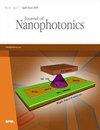Enhancing detectivity in mid-infrared photodetectors through structural parameter engineering in HgSe-HgTe colloidal quantum dots
IF 1.1
4区 物理与天体物理
Q4 NANOSCIENCE & NANOTECHNOLOGY
引用次数: 0
Abstract
The escalating demand for cost-effective, flexible, and solution-processed materials in infrared (IR) photodetection presents a compelling alternative to current epitaxially grown optoelectronic technology. Colloidal quantum dots (CQDs) have emerged as a versatile platform for optoelectronic device fabrication, offering affordability, low-temperature synthesis, and scalability. Specifically, mercury chalcogenide CQDs exhibit notable intraband absorption in the mid-IR region. In this study, we explore an intraband HgSe-HgTe CQD photodetector structure tailored for mid-IR light detection. Through numerical optimization, we engineer detectivity by varying key design parameters—the film doping density, CQD diameter, and number of periods in the active layer—under different temperatures and biases. Results indicate that, at 60 K and 1 V bias, our optimally designed HgSe-HgTe CQD IR photodetector attains a peak detectivity of 8.14×1010 Jones for a film doping density of 1019 cm−3 of HgSe CQDs, 9.34×1010 Jones for HgSe CQDs with a 4.8 nm diameter, and 8.72×1010 Jones for 9 periods of HgSe-HgTe CQDs.通过 HgSe-HgTe 胶体量子点的结构参数工程提高中红外光探测器的探测能力
红外(IR)光电探测领域对高性价比、灵活的溶液加工材料的需求不断增长,这为当前的外延生长光电技术提供了一个引人注目的替代方案。胶体量子点(CQDs)已成为光电器件制造的多功能平台,具有经济实惠、低温合成和可扩展性等特点。特别是,铬化汞 CQD 在中红外区域表现出显著的带内吸收。在本研究中,我们探索了一种为中红外光探测量身定制的带内 HgSe-HgTe CQD 光电探测器结构。通过数值优化,我们在不同的温度和偏压条件下改变了关键设计参数--薄膜掺杂密度、CQD 直径和有源层的周期数,从而设计出了探测器。结果表明,在 60 K 和 1 V 偏压条件下,我们优化设计的 HgSe-HgTe CQD 红外光探测器在 HgSe CQD 薄膜掺杂密度为 1019 cm-3 时可达到 8.14×1010 琼斯的峰值探测率;在 HgSe CQD 直径为 4.8 nm 时可达到 9.34×1010 琼斯的探测率;在 HgSe-HgTe CQD 有 9 个周期时可达到 8.72×1010 琼斯的探测率。
本文章由计算机程序翻译,如有差异,请以英文原文为准。
求助全文
约1分钟内获得全文
求助全文
来源期刊

Journal of Nanophotonics
工程技术-光学
CiteScore
2.60
自引率
6.70%
发文量
42
审稿时长
3 months
期刊介绍:
The Journal of Nanophotonics publishes peer-reviewed papers focusing on the fabrication and application of nanostructures that facilitate the generation, propagation, manipulation, and detection of light from the infrared to the ultraviolet regimes.
 求助内容:
求助内容: 应助结果提醒方式:
应助结果提醒方式:


